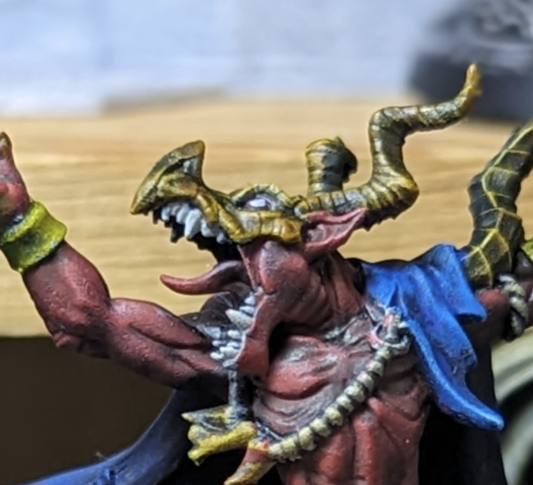Salutations from a complete novice. What’s your recommendations to get started?
Note: A FLGS in town actually has a mini-painting workstation that you can use for $5/session, or as part of their monthly subscription for playing TTRPGs onsite. Since I play PF2E there several times a week I have that subscription. So I have a place to paint that’s already kitted out with just about anything you could need for mini-painting. (I think they charge extra if you want to add stuff like grass, sand, etc. to the mini, but the primer, paints, sealers, etc. are all included.)
I have two awesome minis arriving soon that are unpainted, so I’m looking for online sites/videos that start from “I know nothing” and work up from there.
Thanks in advance for any and all guidance you can provide!


Oh wow, I am the anti-speedpaint user here. SpeedPaint has some applications but it’s better I think to learn the fundamentals with traditional paints, and then use the knowledge and foundation to strategically use speedpaints. I have seen many people start with speedpaints and never progress beyond using them in a very basic way. They are also way expensive for what they are.
Speedpaints are in a way similar to washes in that they have their uses, but you’ll have a lot of voices telling you to just throw them on a model and call it a day. I think that’s like teaching somebody how to build a raft and then letting them drift off into the ocean. It’s very partial advice that doesn’t work without a little more. Learning how to work with traditional paints gives a stronger foundation from which to branch off.
When using washes, there are two main ways to apply: All over or lining/pinwashing. Simple idea. All over you get a big brush and spread the wash over the whole area or even whole model. Lining is more delicate as you trace lines or pull wash into recesses. Both are useful, but I have found that many people, especially new painters will only do all over washing. It’s tempting since it is fast, however it darkens and muddies the whole area. Sometimes you want that, other times you don’t. The result is you either leave the model dark, and possibly not great looking, or you do a touch up and repaint the raised areas- which can be very time consuming. Think about that backend work when you are tempted to put wash all over a model and decide if it’s worth it.
YouTube-wise I think the Duncan Rhodes Painting Academy is the channel for beginners.
An early tip would be patience. When you you use wash or SpeedPaint, or even a layer of traditional paint that’s going a bit slow, you don’t want to accidentally brush over it while it’s still wet, and ruin your progress. Something that helps with this in wargaming is getting comfortable doing a squad at a time. You can rotate which model you are doing to reduce your downtime while you wait.
Brush care is very important. Clean out with water often, change out the brush water entirely if you used metallic paints, and at the end of a session some brush cleaner like Masters Cleaner & Preserver can very much extend the life of brushes.
Keep old semi-retired brushes around to do more junky work like stippling or rough drybrushing.
I still use a dry palette (yes really) and when I mix water into my paint I use a dropper bottle or pipette of very clean water, which helps reduce contamination and give control of exactly how much I add.
Layering and underpainting is important and saves a lot of headache. While it is possible to paint yellow directly over a black prime, trust me you don’t want to do it. You want intermediate colors. Check YouTube for precise details on colors choices, but be aware.
I am wary of using true black or true white as a main color. As a primer layer, they are fine, but if you are painting black or white armor you don’t actually want to mainly use black and white. Black can’t be shaded, so for “black” armor making it mainly a dark grey allows for shading the recesses which allows the model to have visible definition. White paint is difficult to work with and almost always has poor coverage. A light grey that is edged or highlighted with pure white will look like white while being much easier to apply.
Once you start painting in a way you like, keep a painting journal. Either physical or a word document that records what paints you used and any special way you applied them. This is a help to your future self when you want to reuse a technique or paint an army consistently.
This is great advice, thank you. I’m just breaking out of my speed paint phase I think but it’s slow going when the immediate results look worse than before!
I followed a painting guide on Patreon recently and I was surprised at how many layers went on to the model. Prime and grey/white drybrush yes, but then a colour layer and then some more white, and then another set of colour and highlights, and then more white in place over that, and then more layers.
The end result looked better but it was way harder work. I’m gonna keep pushing myself beyond speed paints but they are a useful fallback to get a model that is ‘quite good’ in pretty short order.
It’s a good idea to learn to use regular paints, but don’t throw away your contrast or speedpaints. My favorite way to do leather is to paint the area in the highlight color, then use a dark (black or brown) contrast paint on top to make it look like leather.